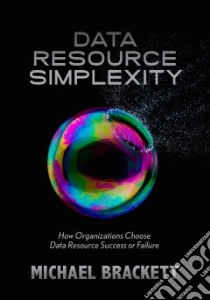Data Resource Simplexity - 9781935504108
Un libro in lingua di Michael Brackett edito da Technics Pubns Llc, 2011
- € 51.50
- Il prezzo è variabile in funzione del cambio della valuta d’origine
Do you fully understand all the data in your organization's data resource? Can you readily find and easily access the data you need to support your business activities? If you find multiple sets of the same data, can you readily determine which is the most current and correct? No? Then consider this book essential reading. It will help you develop a high quality data resource that supports business needs.Data Resource Simplexity explains how a data resource goes disparate, how to stop that trend toward disparity, and how to develop a high quality, comparate data resource. It explains how to stop the costly business impacts of disparate data. It explains both the architectural and the cultural aspects of developing a comparate data resource. It explains how to manage data as a critical resource equivalent to the other critical resources of an organization—finances, human resource, and real property.Drawing from his nearly five decades of data management experience, plus his leveraging of theories, concepts, principles, and techniques from disciplines as diverse as human dynamics, mathematics, physics, agriculture, chemistry, and biology, Michael Brackett shows how you can transform your organization's data resource into a trusted invaluable companion for both business and data management professionals.Chapter 1 reviews the trend toward rampant data resource disparity that exists in most public and private sector organizations today—why the data resource becomes complex. Chapter 2 introduces the basic concepts of planned data resource comparity—how to make the data resource elegant and simple. Chapter 3 presents the concepts, principles, and techniques of a Common Data Architecture within which all data in the organization are understood and managed.Chapters 4 through 8 present the five architectural aspects of data resource management. Chapter 4 explains the development of formal data names. Chapter 5 explains the development of comprehensive data definitions. Chapter 6 explains the development of proper data structures. Chapter 7 explains the development of precise data integrity rules. Chapter 8 explains the management of robust data documentation.Chapters 9 through 13 present the five cultural aspects of data resource management. Chapter 9 explains the development of a reasonable orientation for the data resource. Chapter 10 explains acceptable data availability to the business. Chapter 11 explains adequate data responsibility for the data resource. Chapter 12 explains an expanded data vision for managing the data resource. Chapter 13 explains how to achieve appropriate data recognition.Chapter 14 presents a summary explaining that development of a comparate data resource is a cultural choice of the organization and the need for a formal data resource management profession.From the Foreword, by Chris Potts, author of fruITion and recrEAtion: The challenge, as Michael observes in the very first chapter, is that you can't actually administer, manage, or govern data, only people's choices about data. This crucial and valuable insight - and what to do about it - is one of many that the author offers us from more than 40 years in the 'data game', as he calls it. Tellingly, he has looked outside of the data management discipline for some of the answers we need, thereby persuading us to innovate in our understanding of the problems we have with data, and of the solutions for dealing with those problems.My first corporate strategy role, back in the early 1990s, was in information architecture. As Michael recounts from his own experiences and others, in the intervening time, much has changed and nothing has changed. New business ideas and technologies come, and some old ones go. But truths survive. Data are assets, and we choose how to manage them. These are the essential truths on which good data management strategies will always be built.
Informazioni bibliografiche
- Titolo del Libro in lingua: Data Resource Simplexity
- Sottotitolo: How Organizations Choose Data Resource Success or Failure
- Lingua: English
- Autore: Michael Brackett
- Editore: Technics Pubns Llc
- Collana: Technics Pubns Llc (Paperback)
- Data di Pubblicazione: 01 Aprile '11
- Genere: COMPUTERS
- Pagine: 642
- EAN-13: 9781935504108


